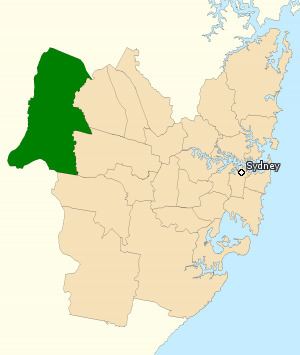Created 1984 Electors 109,779 (2016) Area 339 km² | Demographic Outer Metropolitan Founded 1984 Elector 109,779 | |
 | ||
The Division of Lindsay is an Australian electoral division in the state of New South Wales. The division is named after Sir Norman Lindsay, the prominent Australian artist, writer and sculptor. The division was proclaimed at the redistribution of 11 October 1984 and was first contested at the 1984 federal election.
The division is located in the outer western suburbs of Sydney, and is centred on Penrith. It also includes the suburbs of Berkshire Park, Cambridge Gardens, Cambridge Park, Castlereagh, Claremont Meadows, Colyton, Cranebrook, Dunheved, Emu Heights, Emu Plains, Glenmore Park, Jamisontown, Jordan Springs, Kingswood, Kingswood Park, Lemongrove, Leonay, Llandilo, Londonderry, Mount Pleasant, North St Marys, Oxley Park, Regentville, South Penrith, St Marys, Werrington, Werrington County, and Werrington Downs; as well as parts of Agnes Banks, Badgerys Creek, Luddenham, Mulgoa, and Orchard Hills.
Ever since Lindsay was first contested at the 1984 federal election the seat had always elected a member of the government of the day − a pattern known as a "bellwether" seat. However, Lindsay's bellwether run ended at the 2016 federal election when Labor's Emma Husar defeated one-term Liberal Fiona Scott. Ahead of the 2016 election, ABC psephologist Antony Green listed Lindsay in his election guide as one of eleven which he classed a bellwether electorate.
History
The Division of Lindsay has bellwether status. At every federal election since its creation in 1984, its winning member of parliament has been from the party winning government. This has been widely attributed to Lindsay's buildup as an economically sensitive seat. The mortgage belt status of the electorate means fiscal matters such as interest rates, job security, petrol prices and quality of transportation are always critical issues at federal elections. The geographic buildup of the seat consists of Liberal voting areas in the west, Labor voting areas in the east and swing areas in the centre.
Prior to the 1996 election, it was considered a safe Labor seat, as it was located in Labor's longstanding heartland of west Sydney. This ended in 1996, when then member Ross Free was thrown from office by Liberal challenger Jackie Kelly on a swing of nearly 12 percent. Free was one of 13 New South Wales Labor MPs to lose their seats in Labor's heavy defeat that year. However a by-election was called when it was revealed that questions about Kelly's citizenship raised eligibility problems. Kelly won the subsequent by-election with an additional 6.69% swing towards her.
Kelly announced her retirement in 2007 which, together with the 2006 redistribution, made Lindsay vulnerable to the Labor candidate, Penrith Mayor David Bradbury. In his third bid for the seat, Bradbury won with a swing of 9.7% after distribution of preferences, defeating the unsuccessful Liberal candidate Karen Chijoff. Three days before the 2007 federal election Liberal Party supporters, including Jackie Kelly's husband, were caught in Lindsay distributing fake pamphlets in residents' letterboxes which linked the Labor Party to Islamic terrorism. For more details see Lindsay pamphlet scandal. Bradbury narrowly retained the seat in 2010 against Liberal Fiona Scott, but she defeated him at the 2013 election receiving a favourable swing towards her in both elections of 5.16% in 2010 and 4.11% in 2013.
However, the bellwether streak ended at the 2016 federal election as Labor's Emma Husar defeated Scott to claim the seat, while overall the Liberal/National coalition narrowly retained government.
